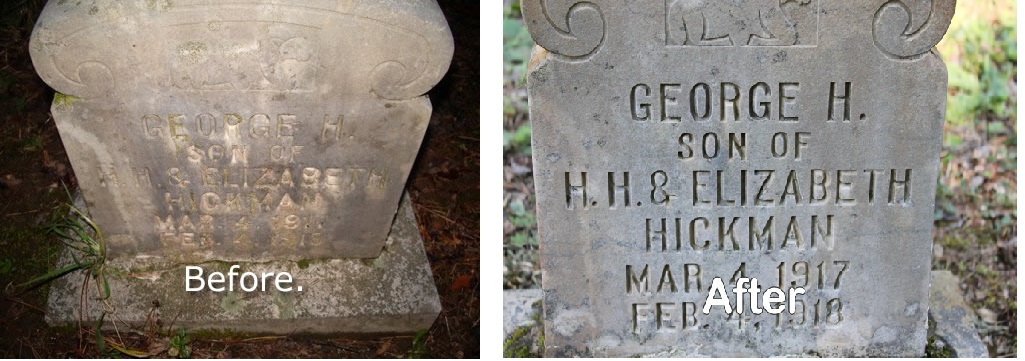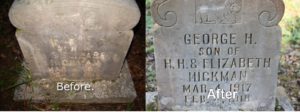Cleaning Tombstones and Gravestones Without Causing Damage
We are often asked how to properly clean a tombstone. The most important aspect of tombstone cleaning is to DO NO DAMAGE. Gravestones can be fragile and they can contain hidden, subsurface flaws that will be exacerbated by rough handling.
This quick 5 step process will help you assess a tombstone and take gentle steps to perform a proper cleaning, if necessary.
1: Inspect the Tombstone to look for preexisting damage or the potential of future damage.
Tombstone cleaning can cause, reveal, and exacerbate damage to the tombstone. Before attempting to clean a tombstone, thoroughly inspect the entirety of the stone. Look for surface and subsurface cracks and faults that will be damaged if improperly handled. Assess the type of stone and its stability. Soft stone material and stones with tendencies to flake or crumble require much more delicate handling.
Stones that are unstable or damaged should be avoided and reported to cemetery management.
If the tombstone is unsuitable for cleaning, it is much better to leave it alone rather than to cause damage or increase existing damage.
2: Use plenty of water to wet and wash the gravestone.
Surface dirt can often be washed away with generous quantities of water. In cemeteries with available running water, use a water hose to gently rinse away surface dirt and lichen growth. “Gently” is the keyword here. Never use pressure washers on gravestones. One technique I like to use is to place my thumb over the open end of the water hose to form a gentle spray. There is a special method of wetting the stone that will greatly improve the final look once you complete your tombstone cleaning. We describe this technique in the Grave Care Business Course.
3: Use a non-ionic cleaner, if necessary.
Cemetery preservationists suggest using non-ionic cleaners to kill biological growth on gravestones. Grave markers are porous. Therefore, it’s important to use cleaners that will not damage the stone by seeping inside and causing corrosion. Harsh chemicals should never be used as they can damage stones even if the damage is not readily apparent.
4: Scrub gently with a soft bristled brush.
If scrubbing is necessary, use soft bristled brushes and plenty of water to gently scrub away surface debris. Once again, “gently” is the keyword. Harsh scrubbing is never recommended since abrasion can damage tombstone material. Additionally, the courses training video on tombstone cleaning describes methods to properly clear heavy lichen and mosses from gravestone surfaces.
5: Rinse the tombstone with generous quantities of filtered or distilled water.
As a final rinse of the tombstone to remove residual dirt or cleaner, use copious amounts of water. If your tap water is high in mineral content (as it is in some parts of the country), filtered or distilled water is preferable.
In closing, the first step is the most important. It is better to delay cleaning a stone rather than to cause irreparable damage to the stone. Take a gentle, methodical approach to your tombstone cleaning.
Here is a government resources you may find helpful:
The U.S. Government Center for Preservation
Cleaning tombstones is a delicate process. Each and every stone is different and requires individual attention.
Have you ever thought about starting your own tombstone cleaning and grave care business?
We have developed a professionally produced business course to help you start & operate your own Grave Care Business. The course teaches you how to incorporate cleaning methods into your Grave Care Business. Video lessons teach you how to clean the stones appropriately. You will also learn how to build a strong client list of customers who will pay you good money to clean tombstones, maintain their loved one’s grave plots, and pay for yearly maintenance packages and yearly floral decoration package. The course also includes pricing strategies and pricing calculators to help you learn how much to charge for your services.
The cost of the Full Grave Care Business Course is only $260.00
Read through our other blog posts and also look though the main pages of our website to learn about the Grave Care Business materials.
Order the full course directly through our website and we will ship it to you directly via USPS Priority Mail.
If you have any questions, please let us know. We are always happy to help.




That’s a good tip to use lots of water. Water is a natural solution and it does a really good job of breaking up dirt. Also, you risk damage if you use more powerful chemicals.
I’ve been going to our family plot a lot and have noticed that a lot of the stones are starting to get more unrecognizable and wondered what I could do to fix that problem. I found it interesting that you said that because the stones are porous you would need to use a non-ionic cleaner so you don’t damage it more. I appreciate your advice and will be following it as closely as I can with this project.
Nothing makes me sadder than seeing a filthy tombstone. I like how you said that the gentle use of water can get rid of a lot of stuff. Are there specific tools or chemicals that can be used on headstones, like things that only professionals would have?
I found it interesting when you explained that it is important to avoid using harsh chemicals when cleaning a gravestone. I would imagine that it would be important to know what kind of cleaner to use when picking out a material to use for the memorial. It would be interesting to learn more about how gravestones are created.